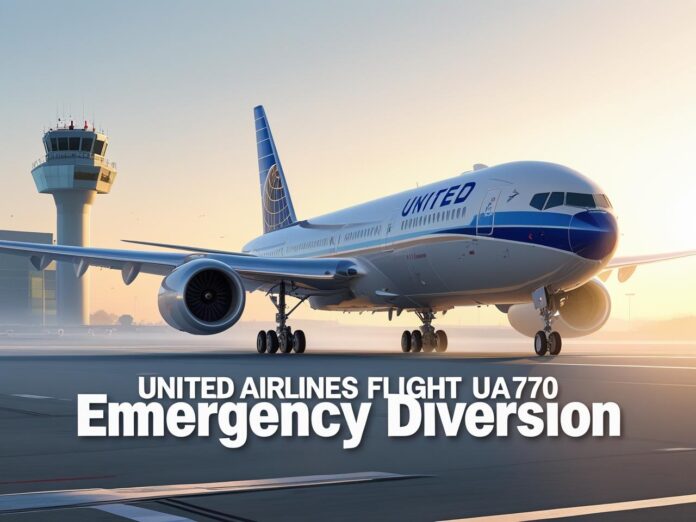Introduction to the Incident
Air travel is one of the safest modes of transportation, but sometimes unexpected events occur that test airline preparedness. United Airlines Flight UA770 recently faced such a situation, requiring an emergency diversion. Let’s break down exactly what happened, why it occurred, and what it means for passengers.
Key Facts About United Airlines Flight UA770
Flight Route and Schedule
United Airlines Flight UA770 is a regularly scheduled route that connects major U.S. cities. On the day of the incident, it was operating as planned with a full load of passengers.
Aircraft Type and Capacity
The flight was serviced by a Boeing 737 aircraft, known for its reliability and extensive use across global airlines. With a capacity of around 160 passengers, it’s a workhorse of the aviation industry.
Timeline of the Diversion
When and Where It Occurred
Midway through the journey, the flight crew detected an issue that warranted precautionary action. The plane was safely diverted to the nearest suitable airport to ensure passenger safety.
Immediate Actions by the Crew
Pilots quickly communicated with air traffic control, requested priority landing clearance, and prepared the cabin crew to handle any possible scenario. Passengers were kept informed throughout the process.
Reasons Behind the Diversion
Technical Issues Explained
While initial reports indicated a possible technical fault, the exact nature of the problem is subject to post-flight investigation. Often, such diversions involve minor irregularities caught early thanks to advanced aircraft monitoring systems.
Passenger Safety Protocols
Airlines always prioritize safety over schedule. Even if there’s a hint of abnormality, standard protocol is to divert rather than take chances midair.
How Airline Diversions Work
Communication with Air Traffic Control
Once a potential issue is detected, pilots immediately notify air traffic control to identify the safest and quickest diversion airport.
Prioritizing Emergency Landings
Emergency diversions are given landing priority over other flights, reducing waiting times and ensuring swift resolution.
Crew Training for Emergencies
Pilots and flight attendants undergo rigorous simulator training for scenarios just like this, ensuring calm, professional handling in real situations.
Passenger Experience During the Diversion
What Passengers Reported
Some passengers reported hearing announcements about a “precautionary landing,” while others noted that the cabin remained calm, indicating the crew maintained control and clear communication.
How Crew Handled the Situation
The cabin crew’s professionalism reassured passengers. Safety demonstrations, regular updates, and attentive service helped maintain order and calm.
Aftermath of the Diversion
Maintenance Checks and Investigation
After landing, the aircraft underwent thorough maintenance checks. Engineers inspect everything from engines to avionics to confirm flight readiness.
Compensation and Rebooking for Passengers
United Airlines typically assists with rebooking affected travelers and may offer compensation depending on the delay’s impact.
What This Incident Teaches Us About Aviation Safety
Why Diversions Are Precautionary
Diversions usually indicate that safety systems are doing their job—not failing. By acting early, airlines minimize any real risk to passengers.
The Role of Strict Safety Regulations
Every commercial airline operates under strict FAA and international regulations. These rules mandate quick action even for minor irregularities.
How United Airlines Responded
Official Statement
United Airlines issued a statement confirming the diversion, emphasizing that passenger safety was never compromised.
Steps Taken to Prevent Recurrence
The airline reviewed the incident thoroughly and implemented necessary measures, ensuring similar issues are less likely in the future.
Broader Context of Airline Diversions
Common Causes of Diversions
Diversions can occur due to medical emergencies, severe weather, airspace restrictions, or technical anomalies.
Statistics on Safety and Incidents
Despite occasional diversions, modern commercial aviation has an exceptional safety record, with very few serious incidents per millions of flights.
Conclusion – Why Air Travel Remains Extremely Safe
The United Airlines Flight UA770 diversion highlights that the airline industry prioritizes caution above all else. These events may seem alarming, but they’re actually proof that safety systems work exactly as intended. Passengers can continue to fly with confidence, knowing every precaution is taken long before real danger appears.
FAQs
1. What is an emergency diversion?
An emergency diversion is when a flight changes course to land at an alternate airport due to a safety concern or urgent situation.
2. Are diversions common?
They’re relatively rare but not unusual. Most are precautionary and end without incident.
3. Do passengers get compensation?
Depending on the cause and delay length, airlines may offer rebooking, meal vouchers, or travel credits.
4. How do airlines ensure safety after such events?
Aircraft undergo full inspections, and any issues are resolved before returning to service.
5. Should passengers worry about flying after this?
Not at all. Diversions are signs of responsible safety management, not a reason to fear flying.

